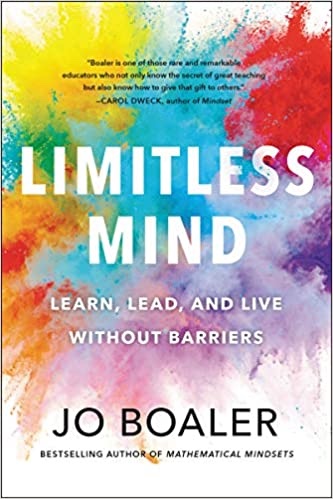
Limitless Mind: Learn, Lead, and Live Without Barriers by Jo Boaler explains what you can do for your own thinking and that of your students to be truly limitless. It draws on educational and brain research that points out that the brain changes when we learn. There is also a focus on the power of mistakes, how changing your mind can change your reality and the benefits of collaboration. Flexible thinking is better than fast thinking and learning is more effective when it is multidimensional. Although Jo comes from the field of math, this book is valuable to all educators and all people.
Introduction: The Six Keys
- We know that the brain changes over time. The concept is called neuroplasticity. This means that if you get stuck when you are trying to learn something, it’s important that you not start thinking that your brain isn’t made for that type of learning. The most common type of learning anxiety that impacts about half of the population is math anxiety. Some also suffer from writing anxiety or think that they have no artistic skills. As the title suggests, everyone should think that their mind and their ability to learn is limitless rather than fixed. This agrees with Carol Dweck’s concept of the growth mindset. See my summary of her book here. When you hit a limit, you need to develop a new strategy rather than quit. Reject stereotypical messages and keep going. Praise students for hard work and creativity rather than telling them they are smart. Above all, make sure they know that you believe in them.
1. How Neuroplasticity Changes Everything
- For the last twenty years or so we have known that the human brain is constantly changing. The brain you have today isn’t the one you woke up with yesterday. We don’t come prewired to be good at some things and bad at other things. We ALL have to work to form and reinforce the neural connections we need to do our jobs and live our lives. The big lesson is don’t let anyone tell you that you can’t learn something and be good at it.
- Boeler sites research that shows how learning disabilities can be overcome with the right kind of brain training. Check out her site at YouCubed.org for more information. There are inspirational stories here about people who were told they couldn’t do something and ended up doing great things. Most schools also have gifted programs. The idea that you can identify some kids as gifted reinforces a fixed-brain way of thinking. Gifted kids can benefit from gifted programs, but when they struggle they are likely to give up thinking that their fixed brain has reached its limit. Regardless of what kind of brain you are born with, what you learn will depend on how hard you work and struggle, not what you started with. Jo also writes about how stereotypes regarding women and minorities can lead to lower expectations and lower achievement.
2. Why We Should Love Mistakes, Struggle, and Even Failure
- The times we struggle and make mistakes are the best times for brain growth. Teachers need to promote this concept and learn how to make students struggle. People who face struggle and stop no doubt have a fixed mindset. Students should know that they don’t always have to be right as it’s not good brain exercise. Schoolwork should be challenging. You learn at the edge of your understanding, which shouldn’t be too easy.
- Self-testing and peer-testing are valuable, as retrieval reinforces your brain’s memory circuits. The steps of struggle include, I don’t know this, this isn’t easy, I’m confused, I need to work hard on this, and I think I’m getting it. All of this is true even for kindergarten or younger. Understanding the positive benefits of mistakes can unlock a limitless life. You don’t want to let children give up to save them from struggle as your efforts are likely to backfire. Rather, support them as they struggle. Never give up on any student. See challenge as an opportunity. Change your negative self-talk to positive self-talk. Be guided by your interests, not your fears.
DrDougGreen.com If you like the summary, buy the book





